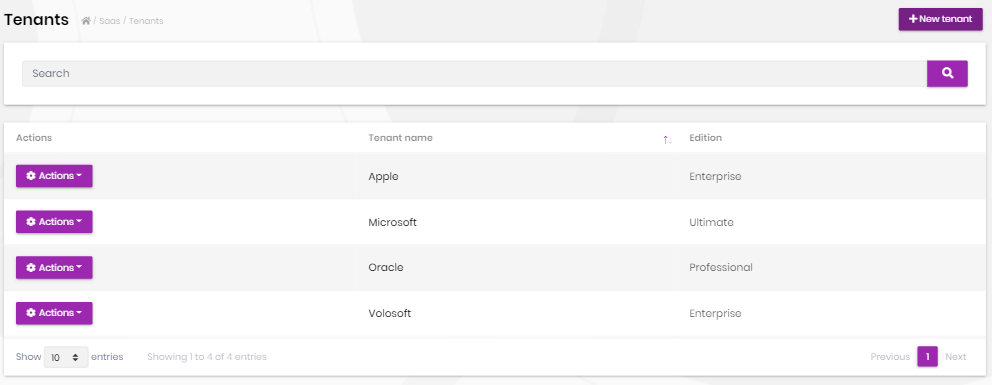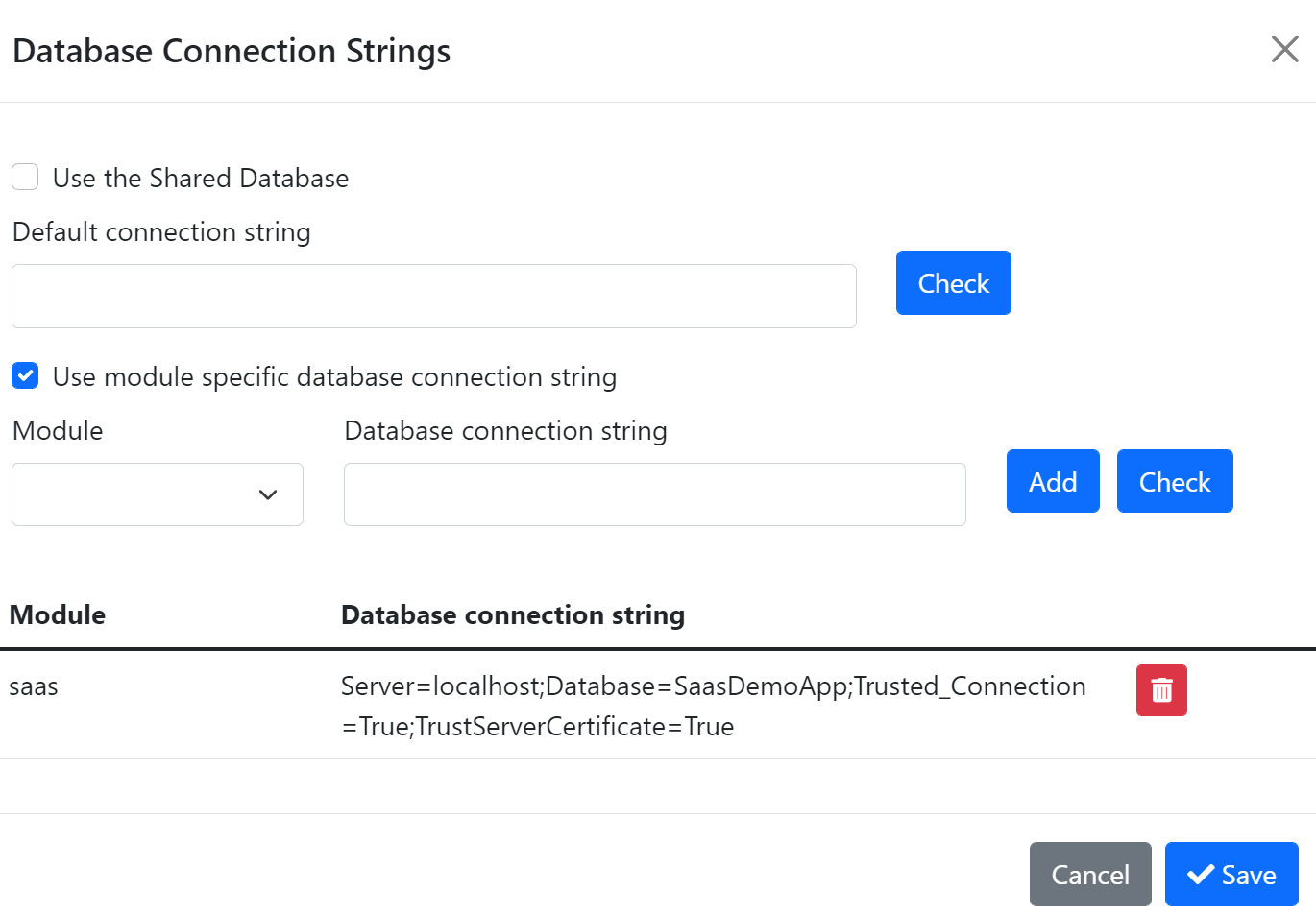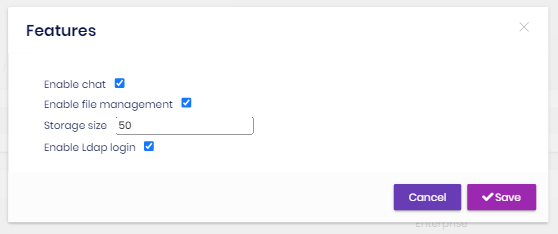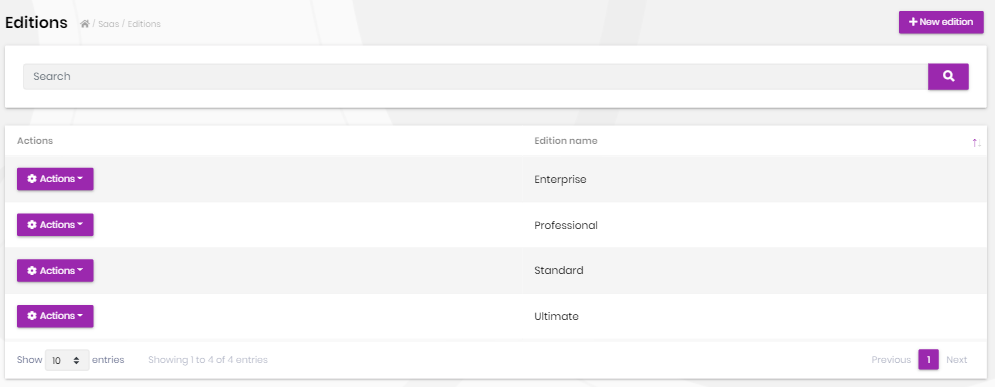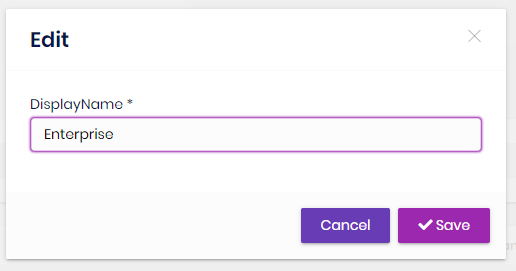SaaS module
This module is used to manage your tenants and editions in multi-tenant applications;
- Manage tenants and editions in the system. A tenant is allowed to have one edition.
- Set features of tenants.
- Set connection string of tenants.
- Set features of editions and tenants.
See the module description page for an overview of the module features.
How to install
Saas is pre-installed in the startup templates. So, no need to manually install it.
Packages
This module follows the module development best practices guide and consists of several NuGet and NPM packages. See the guide if you want to understand the packages and relations between them.
You can visit SaaS module package list page to see list of packages related with this module.
Tenant-Edition Subscription
SaaS module implements subscribing to Editions for Tenants using Payment module. To enable it, project must contain Volo.Saas and Volo.Payment modules and these modules must be configured as shown below.
Configuration
Firstly, Payment module must be configured properly:
Install
Volo.Paymentmodule.abp add-module Volo.PaymentOr you can install via using ABP Suite.
Configure Saas module to use Payment.
Configure<AbpSaasPaymentOptions>(options => { options.IsPaymentSupported = true; });Follow the subscriptions section of Payment Module Documentation. Complete enabling webhooks and configuring plans sections.
Run the application and go to
Saas > Editionspage at your Web Application menu.Create or Edit an existing Edition. Plan dropdown must be visible if you've done earlier steps correctly. Pick a Plan for Edition.
Usage
SaaS module doesn't contain a public facing list page for listing editions for new customers/tenants to subscribe. First, you need to create such a page in your application. Then, when a new customer/tenant selects one of those Editions, you can create a subscription and redirect user to payment module as shown below.
Inject
ISubscriptionAppServiceto create a subscription for a edition:public class IndexModel : PageModel { protected ISubscriptionAppService SubscriptionAppService { get; } protected ICurrentTenant CurrentTenant { get; } public IndexModel( ISubscriptionAppService subscriptionAppService, ICurrentTenant currentTenant) { SubscriptionAppService = subscriptionAppService; CurrentTenant = currentTenant; } public async Task<IActionResult> OnPostAsync(Guid editionId) { var paymentRequest = await SubscriptionAppService.CreateSubscriptionAsync(editionId, CurrentTenant.GetId()); return LocalRedirectPreserveMethod("/Payment/GatewaySelection?paymentRequestId=" + paymentRequest.Id); } }
When the payment is completed successfully, the tenant and edition relation will be updated according to subscription status. Make sure Payment Gateway Web Hooks are configured properly.
After all, payment module will redirect user to the callbackUrl if configured in payment configuration with a paymentRequestId parameter. In this page, you can check the status of the payment request and show a success message to the user when the payment status is confirmed. Since the payment confirmation is asynchronous, you need to check the payment status repeatedly until it is confirmed.
User interface
Menu items
SaaS module adds the following items to the "Main" menu, under the "Administration" menu item:
- Tenants: Tenant management page.
- Editions: Edition management page.
SaasHostMenuNames and SaasTenantMenuNames classes have the constants for the menu item names.
Pages
Tenant management
Tenant page is used to manage tenants in the system.
You can create a new tenant or edit a tenant in this page:
Connection String
You can manage connection string of a tenant in case you want to use a separate database for a specific tenant. If you want to use Host database for a tenant, select "Use the Shared Database" option.
You can also use the module-specific database connection string feature. In this case, you should select the "Use module specific database connection string" option, then you can determine your modules and their connection strings. Before adding you can check your connection by clicking "Check"
Tenant Features
You can set features of tenants.
Edition management
Editions page is used to manage the editions in your system.
You can create a new edition or edit an existing edition in this page:
Edition Features
You can set features of an edition in this page:
Data seed
This module adds some initial data (see the data seed system) to the database when you run the .DbMigrator application:
- Creates an
Standardedition.
Internals
Domain layer
Aggregates
This module follows the Entity Best Practices & Conventions guide.
Tenant
A tenant is generally represents a group of users who share a common access with specific privileges to the software instance.
Tenant(aggregate root): Represents a tenant in the system.TenantConnectionString(collection): Connection strings of a tenant.
Edition
An edition is typically a category of features of the application.
Edition(aggregate root): Represents an edition in the system.
Repositories
This module follows the Repository Best Practices & Conventions guide.
Following custom repositories are defined for this module:
ITenantRepositoryIEditionRepository
Domain services
This module follows the Domain Services Best Practices & Conventions guide.
Tenant manager
TenantManager is used to create tenants, change and validate name of tenants.
Application layer
Application services
TenantAppService(implementsITenantAppService): Implements the use cases of the tenant management UI.EditionAppService(implementIEditionAppService): Implements the use cases of the edition management UI.SubscriptionAppService(implementISubscriptionAppService): Implements the use cases of Tenant-Edition subscription.
Database providers
Common
Table / collection prefix & schema
All tables/collections use the Saas prefix by default. Set static properties on the SaasDbProperties class if you need to change the table prefix or set a schema name (if supported by your database provider).
Connection string
This module uses Saas for the connection string name. If you don't define a connection string with this name, it fallbacks to the Default connection string.
See the connection strings documentation for details.
Entity Framework Core
Tables
- SaasTenants
- SaasTenantConnectionStrings
- SaasEditions
MongoDB
Collections
- SaasTenants
- SaasEditions
Permissions
See the SaasHostPermissions class members for all permissions defined for this module.
Angular UI
Installation
In order to configure the application to use the SaasModule, you first need to import SaasConfigModule from @volo/abp.ng.saas/config to root module. SaasConfigModule has a static forRoot method which you should call for a proper configuration.
// app.module.ts
import { SaasConfigModule } from '@volo/abp.ng.saas/config';
@NgModule({
imports: [
// other imports
SaasConfigModule.forRoot(),
// other imports
],
// ...
})
export class AppModule {}
The SaasModule should be imported and lazy-loaded in your routing module. It has a static forLazy method for configuration. Available options are listed below. It is available for import from @volo/abp.ng.saas.
// app-routing.module.ts
const routes: Routes = [
// other route definitions
{
path: 'saas',
loadChildren: () =>
import('@volo/abp.ng.saas').then(m => m.SaasModule.forLazy(/* options here */)),
},
];
@NgModule(/* AppRoutingModule metadata */)
export class AppRoutingModule {}
If you have generated your project via the startup template, you do not have to do anything, because it already has both
SaasConfigModuleandSaasModule.
Options
You can modify the look and behavior of the module pages by passing the following options to SaasModule.forLazy static method:
- entityActionContributors: Changes grid actions. Please check Entity Action Extensions for Angular for details.
- toolbarActionContributors: Changes page toolbar. Please check Page Toolbar Extensions for Angular for details.
- entityPropContributors: Changes table columns. Please check Data Table Column Extensions for Angular for details.
- createFormPropContributors: Changes create form fields. Please check Dynamic Form Extensions for Angular for details.
- editFormPropContributors: Changes create form fields. Please check Dynamic Form Extensions for Angular for details.
Services / Models
Saas module services and models are generated via generate-proxy command of the ABP CLI. If you need the module's proxies, you can run the following command in the Angular project directory:
abp generate-proxy --module saas
Replaceable Components
eSaasComponents enum provides all replaceable component keys. It is available for import from @volo/abp.ng.saas.
Please check Component Replacement document for details.
Remote Endpoint URL
The Saas module remote endpoint URLs can be configured in the environment files.
export const environment = {
// other configurations
apis: {
default: {
url: 'default url here',
},
SaasHost: {
url: 'SaasHost remote url here'
},
SaasTenant: {
url: 'SaasTenant remote url here'
},
// other api configurations
},
};
The Saas module remote URL configurations shown above are optional. If you don't set any URLs, the default.url will be used as fallback.
Distributed Events
This module doesn't define any additional distributed events. See the standard distributed events.
